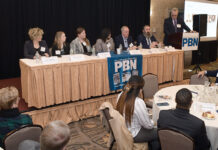Sixty-three percent of the workforce at Aipso, an insurance-industry service provider in Johnston, is female.
But the staff is governed by an all-male leadership team.
“[That] didn’t reflect the population,” said Anne Marie D’Attelo, counsel within Aipso’s legal department. “I think having a leadership team at all levels that’s diverse and reflects the employee population would be considered a success.”
The company’s women’s leadership network, IDEAL, for the past year has been working toward promoting female leadership within the organization, something that local female business leaders say is seriously lacking within the state.
The “2020 Vision for Rhode Island” report, released last week at a Sept. 11 breakfast-panel discussion that included D’Attelo, revealed that of 22 large companies from both the private and nonprofit sectors in the state that responded, none had goals for women’s advancement. And 77 percent of nonprofits reported there were obstacles to advancing women within their organizations.
The survey was presented by Marcia Cone, CEO of the Women’s Fund of Rhode Island, and Susan Colantuono, CEO and founder of Leading Women, who are the Rhode Island delegates to Vision 2020, a national initiative to promote female equality that was developed by the Institute for Women’s Health and Leadership at Drexel University College of Medicine.
“This [survey is] the first of its kind in Rhode Island,” Cone said. “We hope meaningful conversations will emerge [on] investing in women’s leadership toward economic prosperity.”
The need for female leadership, Cone said, is based on stark evidence that organizations with shared leadership between men and women perform better financially.
A 2009 study published by a team at Harvard Business School reported that Fortune 500 companies with three or more women directors handed out annual charitable contributions 28 times higher than those with no women directors.
“When you look at the economic downturn [studies] show that companies with women [leaders] fared better,” Cone said.
Yet, she and other panel members say, despite the fact that women are nearing 50 percent of the Rhode Island workforce, they are still vastly underrepresented in leadership positions here.
A roadmap on how to fix that is one outcome Cone and Colantuono hope will materialize from the survey.
Renee Aloisio, director of internal operations at LGC&D, a CPA and business-advisory firm in Providence, is a founding member of the company’s women’s initiative, Women Count, which was formed six years ago to foster relationships with women-owned businesses and to establish internal mentoring to LGC&D’s upcoming leaders.
“Part of being successful is to develop a network and develop leadership networking skills. Obviously, the other segment was to make the path for emerging leaders [after us] smoother,” Aloisio said.
Rhode Island business leaders were joined on the panel by Megan Robinson, Pfizer CT collaboration leader, who said her pharmaceutical company developed a mentor-mentee matching program, set up somewhat like an online dating service, that has proven successful in pairing those seeking and guidance and those willing to give it.
Robinson has personally used the service in both capacities.
It’s also a way, she said, to put focus on a company’s succession program.
In the Vision 2020 survey, those companies reporting obstacles to promoting women into leadership positions cited the ability to promote from within as challenging at 22 percent of for-profit companies and 14 percent of nonprofits.
Also, 39 percent of for-profit respondents and 29 percent of nonprofit respondents said managers are not held accountable for talent development.
When D’Attelo and her team went about establishing IDEAL, they developed a business case and secured backing from senior leadership before presenting their plan, which focused on drawing a link between what they wanted to do and the company’s strategic thinking.
Part of that was becoming aware that with some senior leaders nearing the end of their careers, having a pipeline of capable talent in-house would prove essential.
“I think Aipso has a culture that is very in tune with the fact that we are a company that performs a service for a niche market,” D’Attelo said. “We have a good picture of what [leaders] will look like when roles open.”
The initiative is using metrics to keep track of its progress. D’Attelo said there is a four-to-five year window before the program can actually measure success in terms of promoting women.
Panelists also pointed to encouraging would-be female leaders to develop and practice skills outside of the company, specifically via board membership.
Forty-six percent of for-profit survey respondents and 38 percent of nonprofit respondents said their company’s board expects a diverse slate of candidates for open director positions.
LGC&D’s company culture openly encourages women employees to seek those positions and helps conduct searches. The company also assists employees who hold board positions with part of that financial obligation. •
No posts to display
Sign in
Welcome! Log into your account
Forgot your password? Get help
Privacy Policy
Password recovery
Recover your password
A password will be e-mailed to you.












